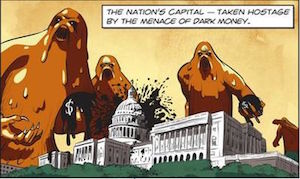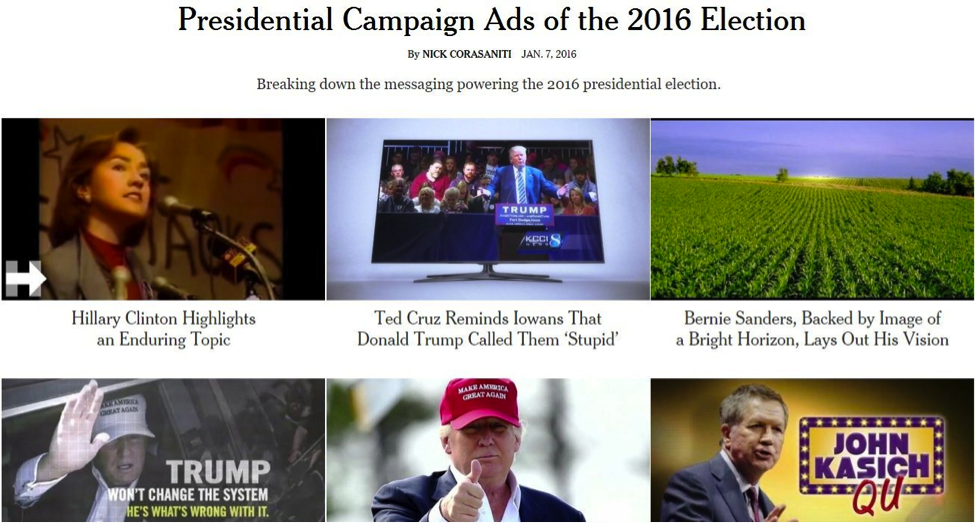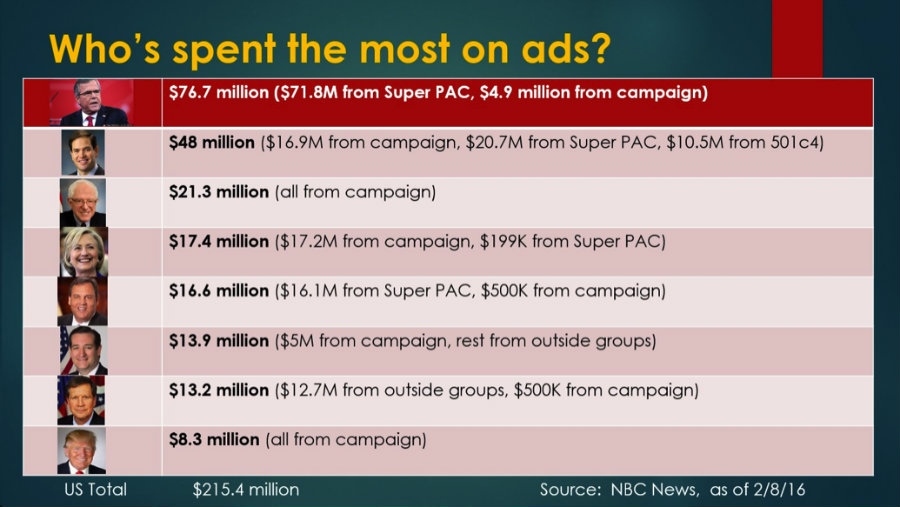Teaching Propaganda Using Political Ads
 By Frank W. Baker
By Frank W. Baker
If you live in Iowa, New Hampshire or South Carolina you could not have escaped the 2016 presidential campaign ads that have inundated broadcast and cable stations. (If you don’t live there, stand by; the ads are coming.)
Four years ago, in this space, I wrote a backgrounder on political TV ads which are slickly produced and highly persuasive.
Four years later, even with big surge in social media, television continues to be the medium that reaches the largest number of potential voters.

“Information, especially of a biased or misleading nature, used to promote or publicize a particular political cause or point of view.”
Sad to say, there may be no source of misformation more ripe for investigation by your students as they study persuasion and argument.
A new website, the Political Ad Archive, is one place you can go to find all of the campaign spots. The New York Times has also created an ad web resource.
Political Ads in ELA and Social Studies Classrooms
Before Common Core, teachers might have used these types of ads to teach persuasion techniques or persuasive writing. The CCSS prefers the term “argument” or argumentative writing. (Here’s an interesting post considering the differences.)
Several Common Core standards are relevant here:
|
W. 9-10.1.a. Introduce precise claim(s), distinguish the claim(s) from alternate or opposing claims, and create an organization that establishes clear relationships among claim(s), counterclaims, reasons, and evidence. W. 9-10.1.b. Develop claim(s) and counterclaims fairly, supplying evidence for each while pointing out the strengths and limitations of both in a manner that anticipates the audience’s knowledge level and concerns. W. 9-10.1.c. Use words, phrases, and clauses to link the major sections of the text, create cohesion, and clarify the relationships between claim(s) and reasons, between reasons and evidence, and between claim(s) and counterclaims. W. 9-10.1.e. Provide a concluding statement or section that follows from and supports the argument presented. L. 9-10. 4.a. Use context (e.g., the overall meaning of a sentence, paragraph, or text; a word’s position or function in a sentence) as a clue to the meaning of a word or phrase. |
For more than 15 years, I have maintained a media literacy website, The Role of Media In Politics, to provide educators with resources and activities and to help them feel more comfortable teaching with and about the relentless stream of 30-second political spots during campaign season.
Because these political commercials go by so quickly, it will be necessary to play back ads more than once in order to engage your students in “active, critical viewing skills.” One way to do that is to consider using my Political Campaign Ad Questions & Worksheet.
I recently suggested the following questions that teachers could use as starting points:
1. Who creates these ads?
2. What are the most common argument-techniques used in these ads?
3. Do those clichéd techniques actually work?
4. How much does it cost to buy time on television?
5. Why is there a large discrepancy between what a candidate pays for time and what a Super PAC pays?
6. Who benefits when campaigns buy time on TV?
7. How much money in total is expected to be spent on political advertising in the 2016 election cycle?
8. What are some of the TV programs I watch where I am most likely to see these ads?
On my website, I provide answers to most of these questions. After some discussion centered on these questions, students can analyze some real political ads.
My advice is to show the ad first with no instruction. Next, distribute the worksheet. Assign students one of the columns. Ask them to pay careful attention. Play the ad again. Have them share their observations.
Most of us, including our students, watch these ads passively. The worksheet activity engages them in active viewing – tasking our students with deconstructing the ads based on many factors: images, sounds, and much more.

Engaging Students in Commercial Ad Scriptwriting
What would students say if they could represent candidates through media advertising? Find out by trying this activity:
1. Assign your students or groups of students to one of the presidential candidates.
2. Next, have them choose (or assign them) one of the 2016 campaign issues.
3. Ask them to research their candidate’s position on that issue. (This research could include the candidate’s own website, their speeches, or other resources such as OnTheIssues.)
4. Using a simple 30-second script template, have them write a commercial for their candidate. (Students might look at this 2012 Obama TV ad with audio transcript to see how words and visuals are blended.)
5. They should also consider: who is the audience for my ad; what TV program or series will I buy time on in order to broadcast my ad to the target audiences I want to reach?
Some of the candidates for the GOP nomination have been airing spots in early primary states since late 2015. According to NBC News, Jeb Bush and the Super PAC supporting him, have spent the most money in the United States so far on ads ($76.7 million), while Donald Trump has spent the least. Democrats fall in the middle.
The 2016 campaign season offers another teachable opportunity moment. When we provide students with critical thinking questions and active viewing skills, we guarantee that they will watch differently. Thomas Jefferson famously said that the health of our democracy depends on an informed electorate. Engaging students in these political messages, and pulling back the curtain on the techniques, is just another step in their becoming informed citizens.
_______________
Frank W. Baker, author of Political Campaigns & Political Advertisements: A Media Literacy Guide, has conducted hundreds of workshops for teachers and students around the United States. He helped write teaching standards for both English Language Arts and Visual/Performing Arts in his home state of South Carolina. He serves as a consultant to the Writing Improvement Network and to the Academy of Motion Picture Arts & Sciences. He maintains The Media Literacy Clearinghouse He tweets about media and media issues @fbaker.





































